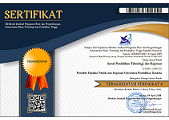DEVELOPMENT OF THE PROPOSED MICROLEARNING-BASED DYNAMIC INTELLECTUAL LEARNING SYSTEM TO ACTUALIZE AN EFFECTIVE LEARNING PROCESS IN ONLINE ENVIRONMENT
DOI:
https://doi.org/10.23887/jptkundiksha.v21i1.75672Keywords:
microlearning, mastery learning, sistem DIL-MicLearn, proses pembelajaran yang efektifAbstract
The era of educational transformation in the 21st century is a stream of change where teachers and students simultaneously hold an important role in the learning process. In this matter, it is necessary to apply innovation and technology integration to realize an effective learning process. This study aims to build a dynamic intellectual learning system based on microlearning (DIL-MicLearn system) which is accessed via the web. This research uses a theoretical-descriptive-development method that uses theoretical studies, software development proses, and expert evaluation. The research phase used is the first two stages of the Plomp design research model, namely the Prelimentary Research stage, and the Development or Prototyping phase. The DIL-MicLearn system is a personalized learning system that allows students to achieve learning mastery in each learning unit according to their cognitive abilities and learning speed, can access learning content according to learning styles, and can reduce students' cognitive load in the learning process. The DIL-MicLearn system is implemented in a online learning environment, considering the characteristics of this system. The advantages and disadvantages of this system are described in detail. The validity level of the DIL-MicLearn system reaches 99.57% and this system is valid for use in the learning process.
References
L. Sumardi, A. Rohman, and D. Wahyudiati, “Does the Teaching and Learning Process in Primary Schools Correspond to The Characteristics of The 21st Century Learning?,” Int. J. Instr., vol. 13, no. 3, pp. 357–370, 2020, doi: 10.29333/iji.2020.13325a.
I. K. Sudarsana et al., “Technology Application in Education and Learning Process,” in Journal of Physics: Conference Series, 2019, vol. 1363, no. 1, pp. 1–6. doi: 10.1088/1742-6596/1363/1/012061.
D. Sejdiu and A. Lama, “The importance of the teacher-student relationship and the effect of students ’ learning,” in UBT International Conference, 2021. doi: 10.33107/ubt-ic.2021.488.
A. Shemshack and J. M. Spector, “A systematic literature review of personalized learning terms,” Smart Learn. Environ., vol. 7, pp. 1–20, 2020, doi: 10.1186/s40561-020-00140-9.
D. A. Parker and E. A. Roumell, “A Functional Contextualist Approach to Mastery Learning in Vocational Education and Training,” Front. Psychol., vol. 11, no. June, pp. 1–11, 2020, doi: 10.3389/fpsyg.2020.01479.
T. Pontual Falcão, F. Mendes de Andrade e Peres, D. C. Sales de Morais, and G. da Silva Oliveira, “Participatory methodologies to promote student engagement in the development of educational digital games,” Comput. Educ., vol. 116, pp. 161–175, 2018, doi: 10.1016/j.compedu.2017.09.006.
K. M. N. Alalwneh and I. M. F. Alomari, “The Impact of Personalized System of Instruction (PSI) on the Achievement of the Students in Vocational Courses Introduction,” Int. J. Educ. Res., vol. 6, no. 8, pp. 81–92, 2018, [Online]. Available: https://ijern.com/journal/2018/August-2018/07.pdf
S. Gómez, P. Zervas, D. G. Sampson, and R. Fabregat, “Context-aware adaptive and personalized mobile learning delivery supported by UoLmP,” J. King Saud Univ. - Comput. Inf. Sci., vol. 26, no. 1, pp. 47–61, 2014, doi: 10.1016/j.jksuci.2013.10.008.
C. M. Toquero, “Challenges and Opportunities for Higher Education amid the COVID-19 Pandemic: The Philippine Context,” Pedagog. Res., vol. 5, no. 4, pp. 1–5, 2020, doi: 10.29333/pr/7947.
R. E. Mayer, “Thirty Years of Research on Online Learning,” Appl. Cogn. Psychol., vol. 33, no. 2, pp. 152–159, 2019, doi: 10.1002/acp.3482.
D. C. Oladayo, “Effects of Mastery Learning on Students’ Achievement and Retention in Social Studies,” IJO - Int. J. Educ. Res. (ISSN 2805-413X), vol. 4, no. 7, pp. 15–19, 2021, [Online]. Available: http://ijojournals.com/index.php/er/article/view/478
M. Winget and A. M. Persky, “A pRactical Review of Mastery Learning,” Am. J. Pharm. Educ., pp. 1–11, 2022, [Online]. Available: https://doi.org/10.5688/ajpe8906
S. M. Adeniji, S. K. Ameen, B. U. Dambatta, and R. Orilonise, “Effect of Mastery Learning Approach on Senior School Students’ Academic Performance and Retention in Circle Geometry,” Int. J. Instr., vol. 11, no. 4, pp. 951–962, 2018, doi: 10.12973/iji.2018.11460a.
C. Vlădescu, “Mastery Learning and the Impact of the COVID-19 Pandemic on Teaching and Learning Mathematics in Romanian Schools,” J. Educ. Black Sea Reg., vol. 7, no. 2, pp. 2–23, 2022, doi: 10.31578/jebs.v7i2.258.
D. Thornton and G. Francia, “Gamification of Information Systems and Security Training: Issues and Case Studies,” Inf. Secur. Educ. J., vol. 1, no. 1, pp. 16–29, 2014, [Online]. Available: https://www.dline.info/isej/fulltext/v1n1/3.pdf
S. Wang et al., “When adaptive learning is effective learning: comparison of an adaptive learning system to teacher-led instruction,” Interact. Learn. Environ., 2020, doi: 10.1080/10494820.2020.1808794.
F. Martin, Y. Chen, R. L. Moore, and C. D. Westine, “Systematic review of adaptive learning research designs, context, strategies, and technologies from 2009 to 2018,” Educ. Technol. Res. Dev., vol. 68, no. 4, pp. 1903–1929, 2020, doi: 10.1007/s11423-020-09793-2.
K. Agustini, I. G. P. Sindu, and K. A. Kusuma, “The Effectiveness of Content Based on Dynamic Intellectual Learning with Visual Modality in Vocational School,” J. Pendidik. Vokasi, vol. 9, no. 1, pp. 11–20, 2019, doi: 10.21831/jpv.v9i1.21629.
L. Giurgiu, “Microlearning an Evolving Elearning Trend,” Sci. Bull., vol. 22, no. 1, pp. 18–23, 2017, doi: 10.1515/bsaft-2017-0003.
N. Singh and M. Banathia, “Micro-Learning : A New Dimension to Learning,” Int. J. Sci. Tech. Adv., vol. 5, no. 1, pp. 141–144, 2019, [Online]. Available: https://www.ijsta.com/papers/IJSTAV5N1Y19/IJSTAV5N1R48Y19D1.pdf
R. Gerbaudo, R. Gaspar, and R. Gonçalves Lins, “Novel Online Video Model for Learning Information Technology Based on Micro Learning and Multimedia Micro Content,” Educ. Inf. Technol., vol. 26, pp. 5637–5665, 2021, doi: 10.1007/s10639-021-10537-9.
Z. R. Aldaghi, A. Emadzadeh, H. Mastour, and S. Mohammadi, “The Impact of Micro-Learning Enriched Environment on Learning and Achievement Motivation of Medical Students in Gastrointestinal Anatomy,” Futur. Med. Educ. J., vol. 12, no. 2, pp. 56–60, 2022, doi: 10.22038/FMEJ.2022.57367.1396.
C. Kossen and C. Y. Ooi, “Trialling Micro-Learning Design to Increase Engagement in Online Courses,” Asian Assoc. Open Univ. J., vol. 16, no. 3, pp. 299–310, 2021, doi: 10.1108/AAOUJ-09-2021-0107.
H.-J. So, H. Lee, and S.-Z. Roh, “Examining the Design of Microlearning for Korean Adult Learners,” EdArXiv Prepr., 2020, [Online]. Available: https://doi.org/10.5281/zenodo.4057859
T. Plomp, “Educational Design Research: An Introduction,” in Educational Design Research. Part A: An introduction, T. Plomp and N. Nieveen, Eds. Netherlands: Enshede, 2013, pp. 10–51.
I. G. P. Suharta and I. G. P. Sudiarta, Penelitian Desain: Tren baru untuk penelitian multi tahun, penyusunan skripsi, tesis, dan disertasi [Design Research: A new trend for multi-year research, drafting of theses, theses and dissertations]. Singaraja: Undiksha Press, 2022.
M. Salud, M. D. Santos, D. C. Durano, and A. D. Hortillosa, “The Development of a Proposed Learning Management System for Senior High Schools in the Philippines,” Int. J. Inf. Educ. Technol., vol. 13, no. 3, pp. 430–438, 2023, doi: 10.18178/ijiet.2023.13.3.1823.
J. Garner, P. Denny, and A. Luxton-Reilly, “Mastery Learning in Computer Science Education,” ACM Int. Conf. Proceeding Ser., pp. 37–46, 2019, doi: 10.1145/3286960.3286965.
M. A. C. Noh and S. A. M. Yusuf, “Collaborative Learning Technique within Higher Learning Education Students,” Creat. Educ., vol. 09, no. 14, pp. 2367–2375, 2018, doi: 10.4236/ce.2018.914177.
L. T. T. Minh, “A Case Study of Students’ Views on Effective Online Learning,” AsiaCALL Online J., vol. 12, no. 5, pp. 24–33, 2021, [Online]. Available: https://www.asiacall.info/acoj/index.php/journal/article/view/73/41
T. Sanjabi and G. A. Montazer, “Personalization of E-Learning Environment Using the Kolb’s Learning Style Model,” in 2020 6th International Conference on Web Research, ICWR 2020, 2020, pp. 89–92. doi: 10.1109/ICWR49608.2020.9122314.
M. A. Ghasia and E. P. Rutatola, “Contextualizing Micro-Learning Deployment: An Evaluation Report of Platforms for the Higher Education Institutions in Tanzania,” Int. J. Educ. Dev. Using Inf. Commun. Technol., vol. 17, no. 1, pp. 65–81, 2021, [Online]. Available: https://files.eric.ed.gov/fulltext/EJ1285500.pdf
A. A. Arntzen Bechina, T. Vold, and P. J. Lara-Bercial, “A Model for an Effective Learning Process in Higher Education: An Example from Three User Cases,” Eur. Conf. Knowl. Manag., vol. 23, no. 1, pp. 37–43, 2022, doi: 10.34190/eckm.23.1.737.
D. Salleh, N. Khairudin, and M. Ibrahim, “Micro Learning: Motivating Students’ Learning Interests,” J. Psikol. Malaysia, vol. 36, no. 1, pp. 153–162, 2022, [Online]. Available: https://spaj.ukm.my/ppppm/jpm/article/view/715/547
A. Samant, “Social Contributory Micro-Learning Activities Motivate Learners to Pursue Higher Order Learning Outcomes,” SSRN Electron. J., vol. Januari, pp. 53–57, 2022, doi: 10.2139/ssrn.4024280.
S. Yang and L. Xu, “Research on the Application of ‘micro-learning’ in Tai Chi Teaching,” in Proceedings - 2021 International Conference on Information Technology and Contemporary Sports, TCS, 2021, pp. 529–532. doi: 10.1109/TCS52929.2021.00113.
R. P. Díaz Redondo, M. Caeiro Rodríguez, J. J. López Escobar, and A. Fernández Vilas, “Integrating micro-learning content in traditional e-learning platforms,” Multimed. Tools Appl., vol. 80, no. 2, pp. 3121–3151, 2021, doi: 10.1007/s11042-020-09523-z.
S. Y. Guraya and M. E. Abdalla, “Determining the effectiveness of peer-assisted learning in medical education: A systematic review and meta-analysis,” J. Taibah Univ. Med. Sci., vol. 15, no. 3, pp. 177–184, 2020, doi: 10.1016/j.jtumed.2020.05.002.
E. Bizimana, D. Mutangana, and A. Mwesigye, “Students’ Perceptions of the Classroom Learning Environment and Engagement in Cooperative Mastery Learning-Based Biology Classroom Instruction,” Educ. Res. Int., vol. 2022, pp. 1–14, 2022, doi: 10.1155/2022/5793394.
S. Yokoyama, “Academic self-efficacy and academic performance in Online Learning: A mini review,” Front. Psychol., vol. 9, no. JAN, pp. 1–4, 2019, doi: 10.3389/fpsyg.2018.02794.
S. Z. Salas-Pilco, Y. Yang, and Z. Zhang, “Student Engagement in Online Learning in Latin American Higher Education during the COVID-19 Pandemic: A Systematic Review,” Br. J. Educ. Technol., vol. 53, no. 3, pp. 593–619, 2022, doi: 10.1111/bjet.13190.
A. D. Dumford and A. L. Miller, “Online learning in higher education: exploring advantages and disadvantages for engagement,” J. Comput. High. Educ., vol. 30, no. 3, pp. 452–465, 2018, doi: 10.1007/s12528-018-9179-z.
Downloads
Published
Issue
Section
License
Authors who publish with the JPTK agree to the following terms:- Authors retain copyright and grant the journal the right of first publication with the work simultaneously licensed under a Creative Commons Attribution License (CC BY-SA 4.0) that allows others to share the work with an acknowledgment of the work's authorship and initial publication in this journal
- Authors are able to enter into separate, additional contractual arrangements for the non-exclusive distribution of the journal's published version of the work (e.g., post it to an institutional repository or publish it in a book), with an acknowledgment of its initial publication in this journal.
- Authors are permitted and encouraged to post their work online (e.g., in institutional repositories or on their website) prior to and during the submission process, as it can lead to productive exchanges, as well as earlier and greater citation of published work. (See The Effect of Open Access)












